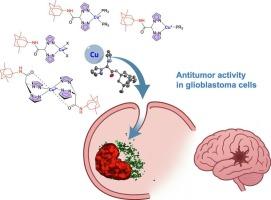美金刚功能化双(吡唑-1-酰)醋酸酯配体支持的铜配合物的合成、结构表征和抗胶质母细胞瘤活性的研究
IF 3.2
2区 化学
Q2 BIOCHEMISTRY & MOLECULAR BIOLOGY
引用次数: 0
摘要
将药物美金刚与双功能物质双吡唑-1-基乙酸偶联,合成了新的配体双(1h -吡唑-1-基)乙酰-3,5-二甲基氨基脲-1-酰胺(LMem),并将其作为铜(II)和铜(I)配合物1-7的支撑配体。在CuI配合物的合成中,选择亲脂的三苯基膦(PPh3)和亲水的1,3,5-三氮杂-7-磷adamantane (PTA)作为共配体,以稳定铜在+1氧化态,并赋予相应金属配合物不同的溶解度。采用高分辨率同步辐射诱导x射线光电子能谱(SR-XPS)和近边x射线吸收精细结构(NEXAFS)对CuI和CuII配位化合物的电子结构和分子结构进行了研究。结合密度泛函理论(DFT)模型和x射线吸收精细结构(XAFS)光谱,在x射线吸收近边缘光谱(XANES)和扩展x射线吸收精细结构(EXAFS)区域研究了铜离子位点周围的局部结构。对合适的晶体进行了x射线衍射(XRD)研究,以描述LMem配体的分子结构和分子间接触。在所有测试的Cu复合物中,化合物4和5在U87, T98和U251胶质瘤细胞系中表现出有效的抗增殖和细胞毒作用。这些影响与活性氧(ROS)产生增加和线粒体功能障碍有关,线粒体去极化和细胞内分布的改变证明了这一点。此外,这些化合物的细胞毒活性被证明是铜依赖的,因为它被铜螯合剂四硫钼酸盐有效地抑制,证实了铜在其作用机制中的重要作用。本文章由计算机程序翻译,如有差异,请以英文原文为准。

Synthesis, structural characterization, and investigation of anti-glioblastoma activity of copper complexes supported by bis(pyrazol-1-yl)acetate ligands functionalized with memantine
The new ligand bis(1H-pyrazol-1-yl)acetyl-3,5-dimethyladamantane-1-amide (LMem) was synthesized by conjugating the drug memantine with the bifunctional species bis(pyrazol-1-yl)acetic acid and used as supporting ligand of copper(II) and copper(I) complexes 1–7. In the synthesis of the CuI complexes, the lipophilic triphenylphosphine (PPh3) and hydrophilic 1,3,5-triaza-7-phosphaadamantane (PTA) were selected as co-ligands, in order to stabilize copper in +1 oxidation state and to confer different solubility properties to the corresponding metal complexes. The electronic and molecular structures of CuI and CuII coordination compounds were investigated by high resolution Synchrotron Radiation-induced X-ray Photoelectron Spectroscopy (SR-XPS), Near Edge X-ray Absorption Fine Structure (NEXAFS) spectroscopy. The local structure around the copper ion sites was studied combining Density Functional Theory (DFT) modelling and X-ray Absorption Fine Structure (XAFS) spectroscopy, in both X-ray Absorption Near Edge Spectroscopy (XANES) and Extended X-ray Absorption Fine Structures (EXAFS) regions. X-ray diffraction (XRD) studies were carried out on suitable crystals to describe the molecular structure and the intermolecular contacts of the LMem ligand. Among all Cu complexes tested, compounds 4 and 5 exhibited potent antiproliferative and cytotoxic effects in U87, T98, and U251 glioma cell lines. These effects were associated with increased reactive oxygen species (ROS) production and mitochondrial dysfunction, as evidenced by mitochondrial depolarization and altered intracellular distribution. Furthermore, the cytotoxic activity of these compounds was shown to be Cu-dependent, as it was effectively inhibited by the Cu chelator tetrathiomolybdate, confirming the essential role of copper in their mechanism of action.
求助全文
通过发布文献求助,成功后即可免费获取论文全文。
去求助
来源期刊

Journal of Inorganic Biochemistry
生物-生化与分子生物学
CiteScore
7.00
自引率
10.30%
发文量
336
审稿时长
41 days
期刊介绍:
The Journal of Inorganic Biochemistry is an established international forum for research in all aspects of Biological Inorganic Chemistry. Original papers of a high scientific level are published in the form of Articles (full length papers), Short Communications, Focused Reviews and Bioinorganic Methods. Topics include: the chemistry, structure and function of metalloenzymes; the interaction of inorganic ions and molecules with proteins and nucleic acids; the synthesis and properties of coordination complexes of biological interest including both structural and functional model systems; the function of metal- containing systems in the regulation of gene expression; the role of metals in medicine; the application of spectroscopic methods to determine the structure of metallobiomolecules; the preparation and characterization of metal-based biomaterials; and related systems. The emphasis of the Journal is on the structure and mechanism of action of metallobiomolecules.
 求助内容:
求助内容: 应助结果提醒方式:
应助结果提醒方式:


